
 |
Home | Kailash Main | Contact |
Updated: October 2011. Click on an image to see the FULL size with a caption.
The following reference information is included:
My rating scale:
 Excellent ;
Excellent ;
 Very Good ;
Very Good ;
 Good ;
Good ;
 Fair ;
Fair ;
 Poor.
Poor.
The travel guides to Tibet have a good description of the Mount Kailash kora and the surrounding area, including Lake Manasarovar and the Guge kingdom:
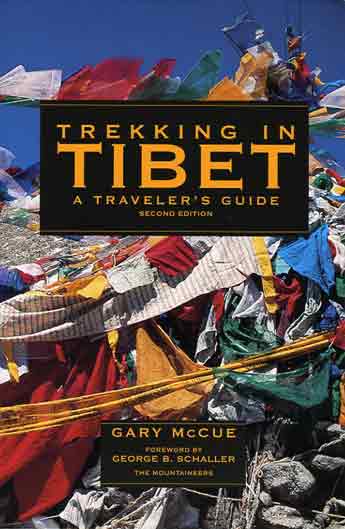
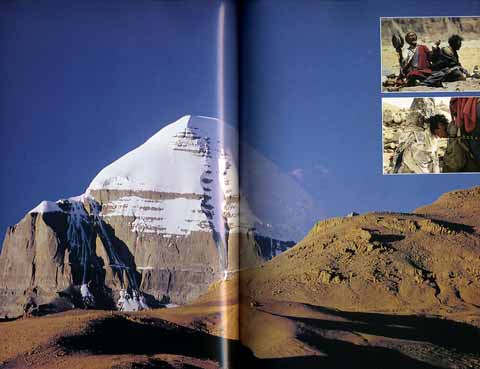

by Gary McCue. An excellent book detailing the popular treks like Kailash and Everest, and more obscure treks like Shishapangma and Menlungtse.

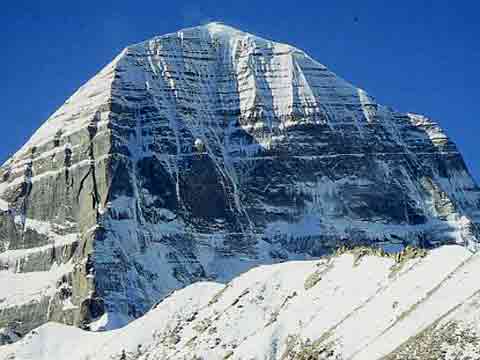

by Sian Pritchard-Jones and Bob Gibbons. An excellent book from Cicerone detailing the Kailash trek, including the Simikot trek and the Guge Kingdom. Contains 11 maps and almost 100 photos.

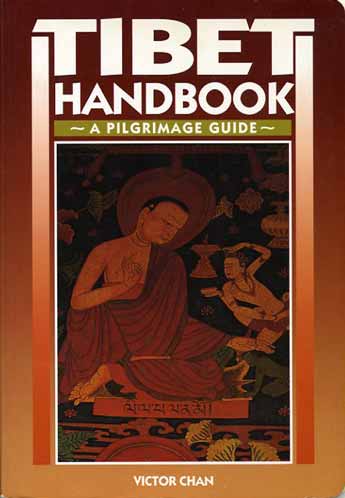


Lonely Planet is my favourite series with the right amount of detail, well written and accurate.

by Victor Chan - over a thousand pages, extremely detailed travel and pilgrimage guide. I highly recommend it if you want to know more than Lonely Planet offers.

by Atsushi Kanamaru (Editor). An excellent book with lots of, eh, maps, detailing among other things the trip to Kailash and the trek around Kailash.
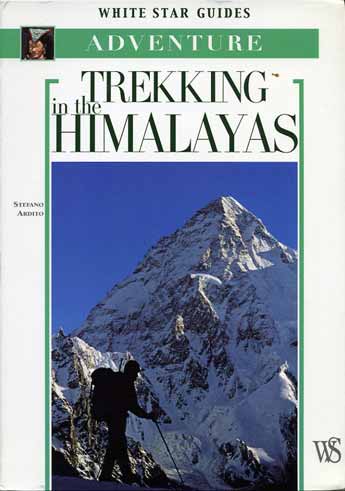
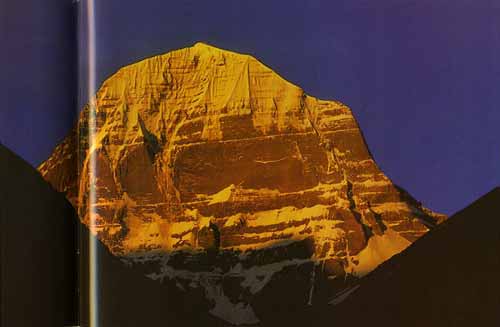

by Stefano Ardito. Published 2006. This trekking guidebook contains basic descriptions of 15 treks: Tirich Mir, Kafir Valleys, around Nanga Parbat, traversing the Biafo and Hispar Glaciers, K2, Zangskar, source of the Ganges, Kailash, Annapurna Sanctuary, around Annapurna, Mustang, Langtang and Helambu Valleys, Everest Nepal, Everest North ABC and Kangshung East Face, and Chomolhari. Each trek has an overview, useful information, a map and a day-by-day description. There are almost 250 photos. The cover is K2.
There are 6 pages on the trek Around Kailash.
The maps and photos are very good.
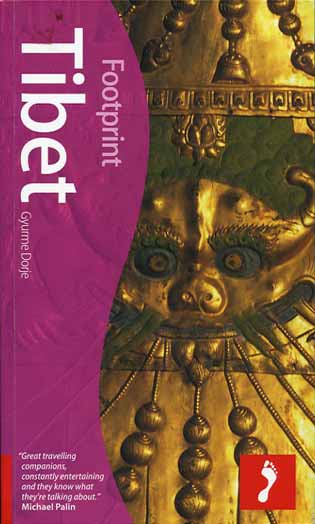
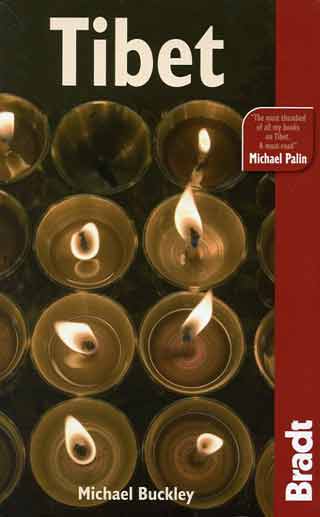

by Gyurme Dorje. The amount of content is a bit more than Lonely Planet. The 14-page section on Kailash and Lake Manasarovar, and the 13-page section on the Guge Kingdom are very good.

by Michael Buckley. The amount of content is less than the Lonely Planet. The maps are very good, but there aren't enough of them. The section on the Guge Kingdom is a bit skimpy. The 6-page section on Kailash is good.
Kailash is featured in several books. Here are my favourites:
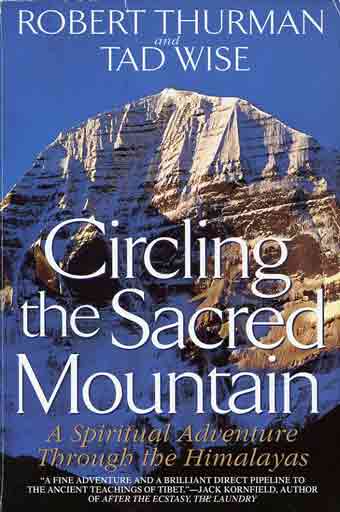
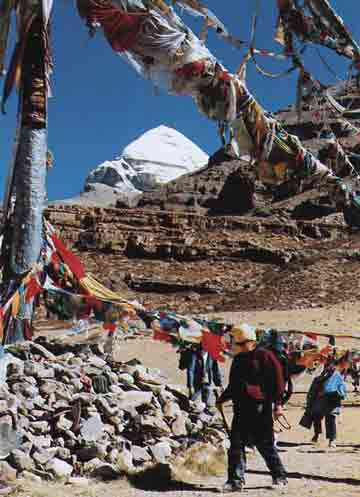

by Robert Thurman, Tad Wise. This is really three books in one. The first is a great travel guide of the 1995 journey to Mount Kailash, its history and significance to Hindus and Buddhists. In the second, Robert Thurman teaches Buddhist basics, and the Blade Wheel of Mind Reform. In the third, Tad Wise reflects on his life and develops his spirituality through Thurman's teachings and the Kailash experience.
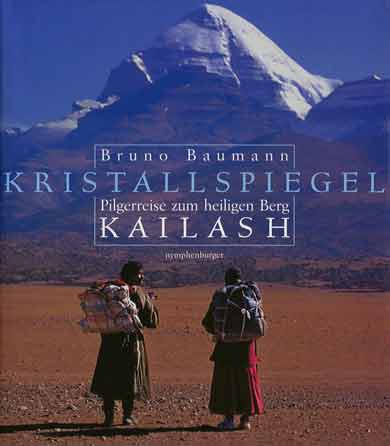
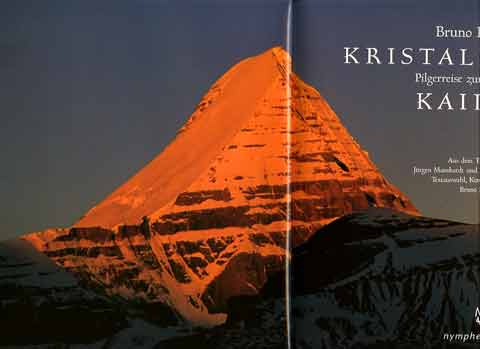
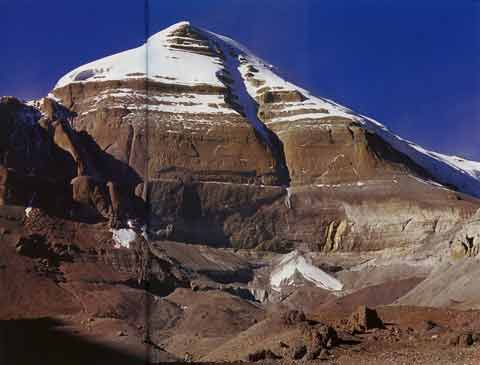

by Bruno Baumann..
This is an absolutely excellent coffee-table-type photographic account of Mount Kailash, Lake Manasarovar, Tirthapuri and Tsaparang (Guge Kingdom). The photo captions are in German, but the photos speak for themselves. You can also check out bruno-baumann.de to see some of his photos, books, etc.
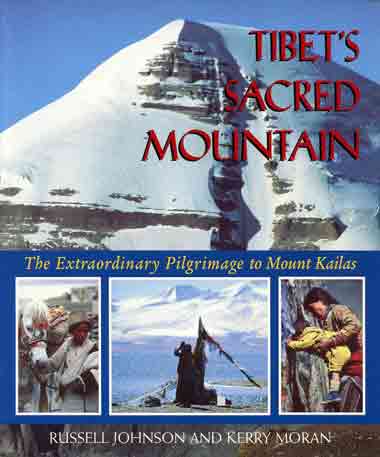
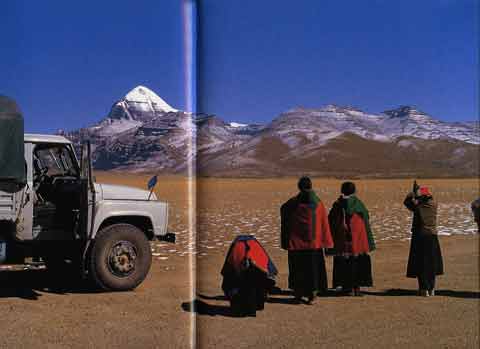

by Russell Johnson, Kerry Moran. Published 1989. This book is illustrated with extraordinarily beautiful photographs showing the journey from Kathmandu to Mount Kailash, Lake Manasarovar and the Kailash kora. It also contains a fairly detailed and easy-to-read description of the history of Mount Kailash, and its significance to both Hindus and Buddhists. If you want just one book to prepare you for Mount Kailash, this is the one.
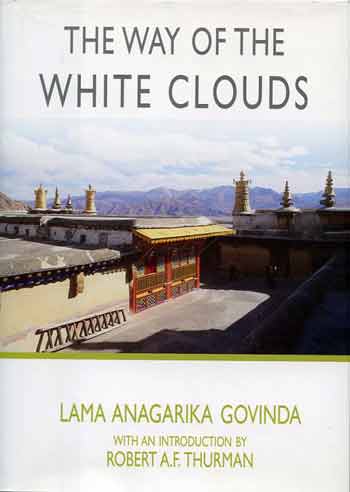
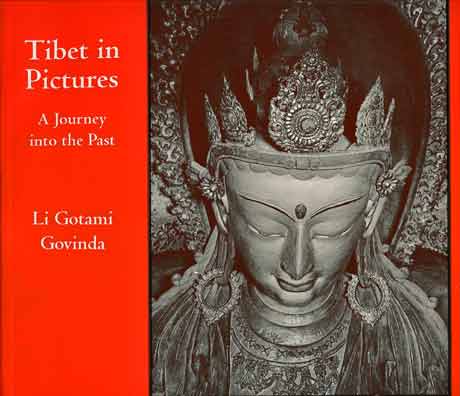

by Lama Anagarika Govinda. Kind of an autobiography, Govinda's recount his travels through Sikkim, Central and Western Tibet, relying heavily on Tibetan Buddhism teachings and traditions. Over half of the book deals with his spirituality and learning from his guru. There are 28 pages describing Kailash and the kora - absolutely excellent! He then travels to Tsaparang, describing his stay and the temples in 31 pages.

by by Li Gotami Govinda. Published 2002. This book is the photographic record of expeditions to Central and Western Tibet undertaken by Li Gotami Govinda and her husband, Lama Anagarika Govinda from 1947-1949. This is the perfect companion book to The Way of the White Clouds illustrating in black and white photos the stories, people and places.
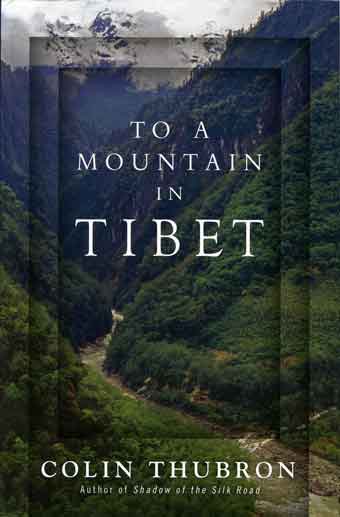

by Colin Thuberon. This book tells the author's trek from Simikot in Nepal to Mount Kailash in Tibet for Saga Dawa in 2009, undertaken to commemorate the recent death of his mother. The first half of the book follows Colin as he treks up the Karnali River from Simkot to Tibet. Colin describes the landscape, his small crew and the villages, villagers, and Buddhist monasteries he encounters. He also reflects on his father and mother along the way.
After entering Tibet they drive to Thalladong Pass for his first view of Lake Manasarovar and Kailash: "we are gazing on a country of planetary strangeness. Beneath us, in a crescent of depthless silence, a huge lake curves empty out of sight. It is utterly still. In the plateau's barren smoothness it makes a hard purity, like some elemental carving, and its colour is almost shocking, a violent peacock blue. There is no bird or wind touched shrub to start a sound. And in the cleansed stillness high above, floating on foothills so faded that it seems isolated in the sky, shines the cone of Mount Kailas. In this heart-stopping moment pilgrims burst into cries and prayer. Even our seasoned trekkers spill from their Land Cruisers to gaze. There seems no colours left in the world but this bare earth-brown, the snow's white, and the sheen of mirrored sky. Everything else has been distilled away. The south face of Kailas is fluted with the illusion of a long, vertical stairway, as if for spirits to climb by. It shines fifty miles away in unearthly solitude. Void of any life, the whole region might have survived from some sacred pre-history, shorn of human complications. We have entered holy land."
He travels to Lake Manasarovar and experiences the Saga Dawa ceremony, with all the pilgrims, the monks and the raising of the Tarboche Pole. He then treks around Mount Kailash, visiting Chuku Gompa and Dirapuk Gompa, describing their statues, and meeting some Hindus who were finding the Kailash parikrama extremely difficult. He passes Shiva Tsal and climbs to the Dolma La. "Now hoarse cries sound above us in the wind, and a hillock of brilliant colour bursts from the gap above. I climb on a wave of relief. The slopes ease apart under a porcelain sky. A few minutes later I am walking through a blaze of prayer flags. They are festooned so thick on everything around that only at their top does the double summit of the boulder sacred to Tara - the Flaming Rock - break free in a surge of granite." He continues the kora down the Eastern Valley to Zutulpuk Gompa and out to the Barkha Plain, where the book ends abruptly.
I enjoyed reading the story once it got to Tibet and to Mount Kailash; the trek in Nepal was a little too long. There is an excellent description of Saga Dawa and the kora around Kailash, but only a basic review of Buddhism and the Tibetan deities. Photos would have helped me visualize the story.
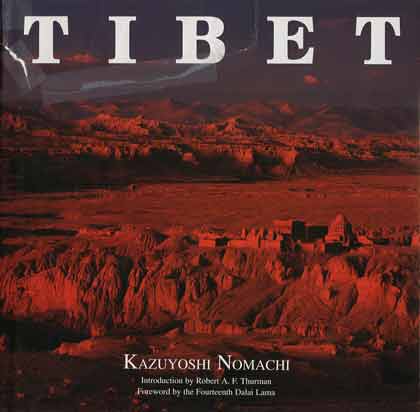
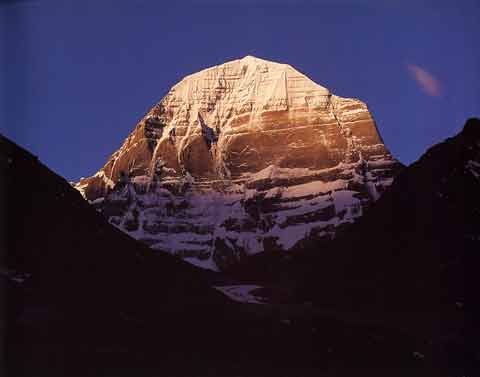

by Kazuyoshi Nomachi
Another excellent coffee-table-type photographic account of Tibet. The cover is Tsaparang. There is a 22-page section on Mount Kailash, and a 24-page section on the Guge Kingdom and Tsaparang and Tholing. There is an introduction by His Holiness the 14th Dalai Lama, another introduction by Robert Thurman, and brief overviews of each photographic area of Tibet in the book. There are some photos of Gyantse, Tingri, and Lhasa, among the other parts of Tibet.
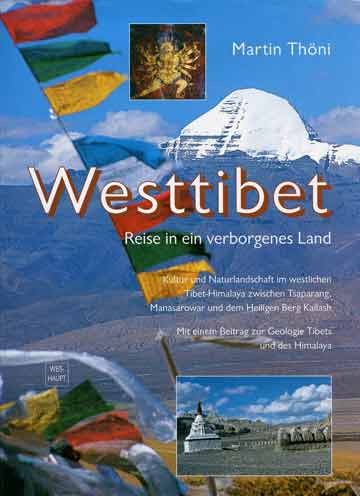
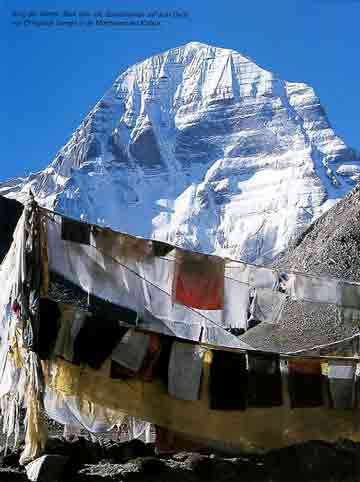
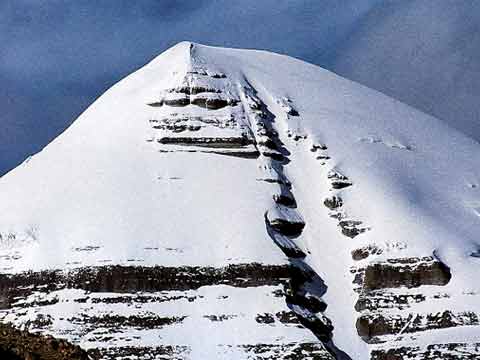

by Martin Thöni
Another great German coffee-style book with excellent photos of Kailash, the Guge Kingdom with Tholing and Tsaparang, and getting to Kailash via road from Kathmandu or by hiking from Simikot.
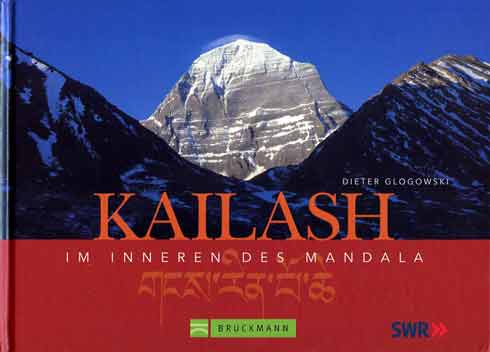
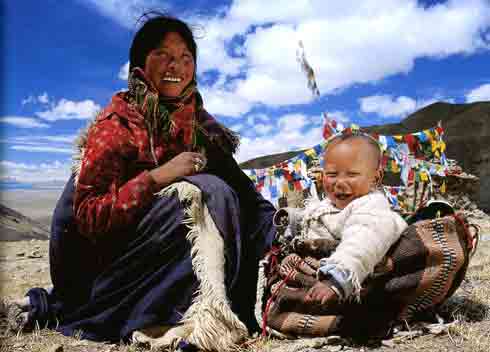
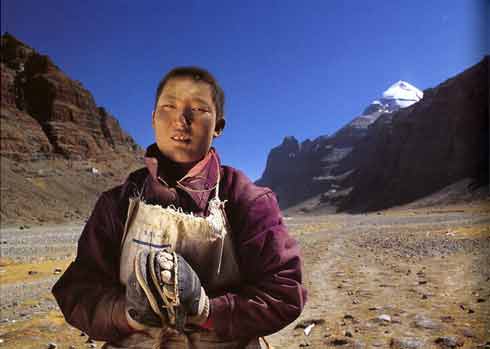

by Dieter Glogowski. Published 2005. After watching Dieter's progress in his trip to Kailash in 2005 at the Jack Wolfskin website, I decided to buy his German book. The German TV and photojournalist's photos are superb. There are very few words in this book, so you're not missing much if you can't understand German - the pictures speak for themselves, from Kailash to the pilgrims.
Go to Dieter Glogowski if you want current information.
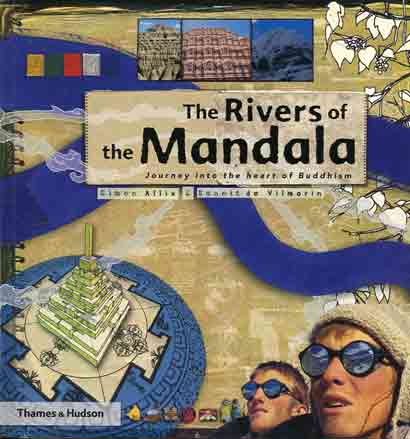
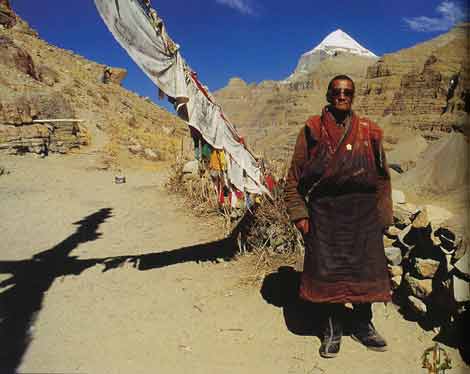

by Simon Allix, Benoit de Vilmorin. Published 2004.
A fun and interesting, very different kind of funky book detailing Mount Kailash and the kora in both interesting text and fantastic photos. Yeee-hah.

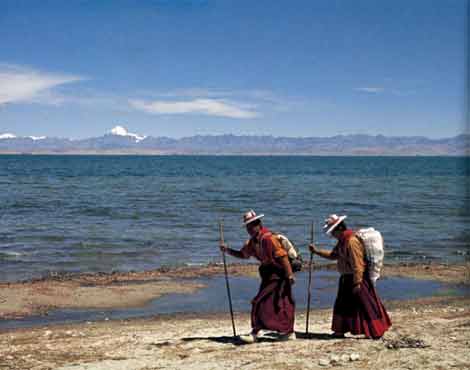
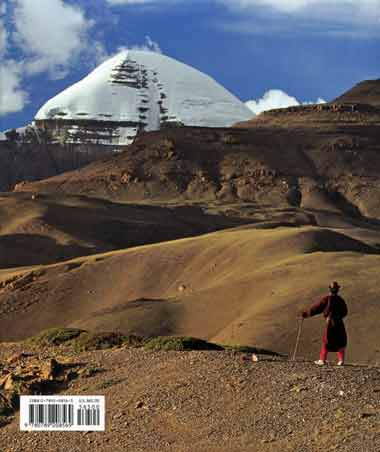
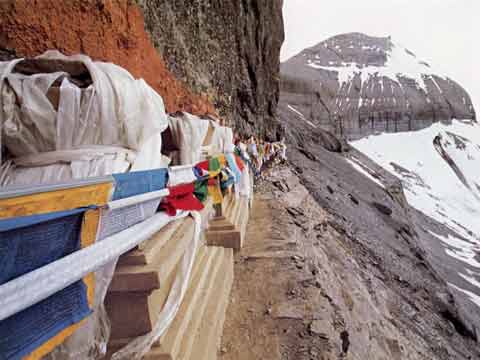

by Gesha Gelek Jinpa, Charles Ramble, and Carroll Dunham. Photogrphs by Thomas L. Kelly. Published 2005. This coffee-table size book documents a prilgrimage by Geshe Gelek, a Bon monk from Kathmandu, in May 2002 to Zhangzhung in the Mount Kailash area of West Tibet. "For Hindus, Kailas is home to the gods Shiva and Parvati; for the Buddhists, the tantric deity Demchog and his scarlet consort Dorje Phagmo; for the Jains, Rishibanatha; and for us Bon, Walchen Gekho." In addition to the day-by-day diary of the trip, there are descriptions of the Bon religion of Tibet, Dzogchen, and its main beliefs and history. There are 160 colour photos.
After flying to Simikot, Geshe Gelek treks to Tibet, does the Lake Manasoravor kora, and the Mount Kailash outer and inner koras. "We crested a ridge [on the inner kora], gazed down into a cirque of snow, the sheer sapphire wall of Mount Kailas behind us, ice and rock cascading off the mountain as the sun softened the snow's surface." After Kailash they visit Tirthapuri and Khyunglung, the ancient capital of Zhangzhung. There are also some photos from Bon areas of Nepal, including Upper Dolpo and Mustang.
The DVD sleeved in the back flap of the book puts in motion picture the whole book thru the gracious words of the commentators and the Bon lamas.
The book does provide a good overview of the Bon religion that predated Buddhism in Tibet. The text interesting. The photos are excellent. The DVD alone is worth half the price of the package
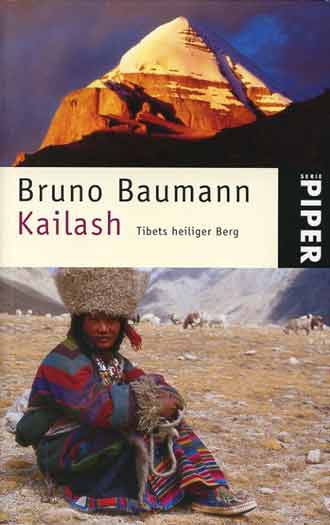


by Bruno Baumann. Published 2006. This 373-page paperback-size book is a great companion to Baumann's Kristallspiegel coffee-table type book, describing his trips to the Kailash area over a 15-year period. It has many more photos, although smaller in size, and some great maps. The text is in German, but the photos speak for themselves.
The book has chapters on Buddhism, getting to the source of the Yarlung Tsangpo (Brahmaputra), trekking from Simikot to Kailash and the source of the Karnali, the Guge Kingdom including Tholing and Tsaparang, to the source of the Indus, Lake Manasarovar, and of course Kailash.

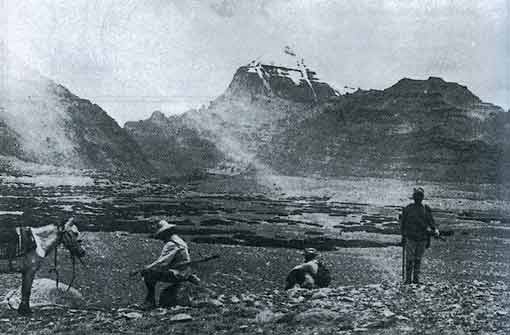

by Charles Allen. This is a great book if you want to know the DETAILED HISTORY of the search for the great holy mountain where four great rivers have their source.
It progresses from the early 1600s to the early 1900s, from the Jesuit priest Father Antonio de Andrade to the famous Swedish explorer Sven Hedin.
Kailash is also featured in a few general travel books. Here is my favourite:
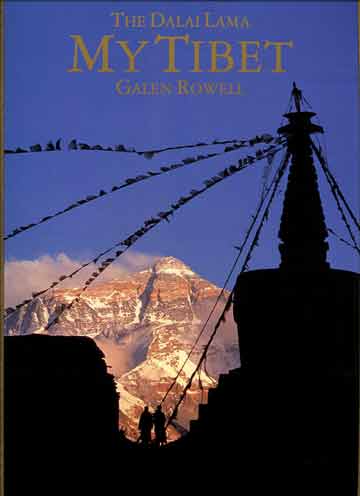
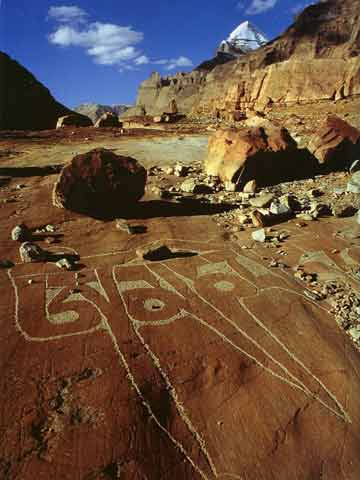
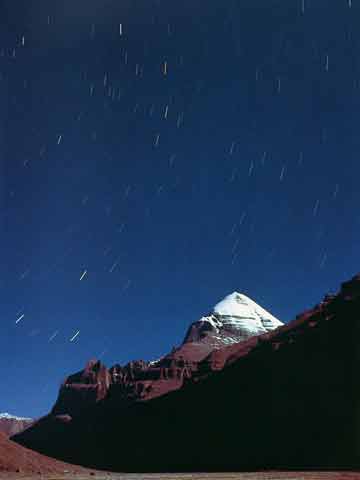

by Galen Rowell. Text by his Holiness the Fourteenth Dali Lama.
This is two books in one. First, it's a coffee-table type book with spectacular photos from world-renowned photographer Galen Rowell. The photos include the mountains and valleys, nomads and pilgrims, animals and plants, and chapters on Amdo, Lhasa, and Mount Kailash.
Second, it features essays by the Dalai Lama that give insight to the photos. His topics include ecology, environment, spirituality, Lhasa and Mount Kailas.
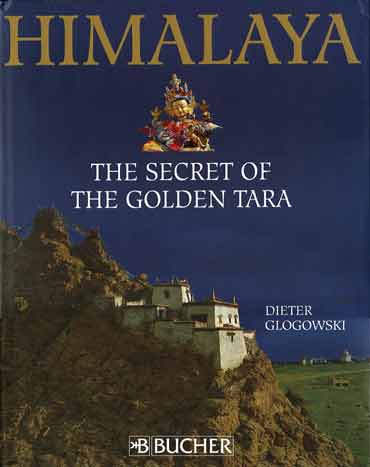
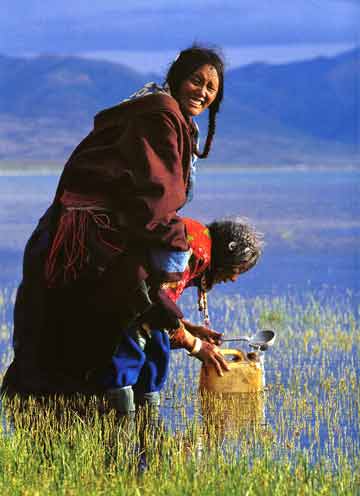
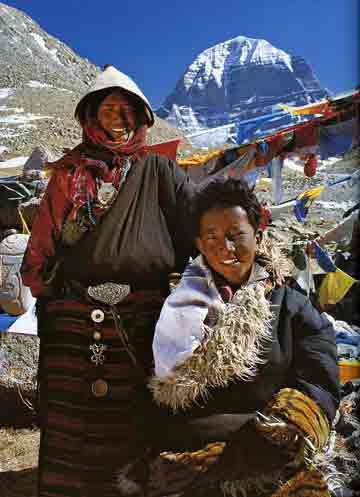
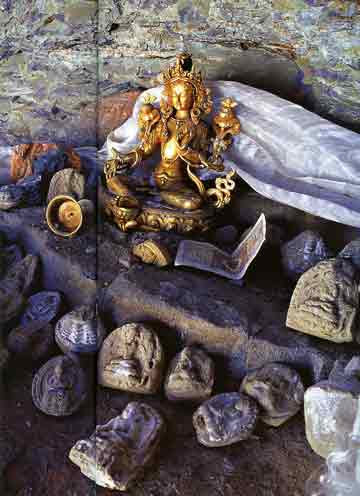

by Dieter Glogowski. Published in English in 2007. This mainly photographic coffee-table book starts with Dieter Glogowski trekking in the cold of winter in February 2003 to visit Sonam Yospel, a 95-year old monk, at Lingshed monastery in Ladakh. When Sonam and his student Pasang decided to escape Tibet in 1966, their abbot gave them a small golden Tara statue to place at the inner mandala of Mount Kailash in Western Tibet. But, Pasang had the statue when Sonam got arrested, and now Sonam wants Dieter to find Pasang and ensure that the statue made its way to Kailash.
Dieter's search for Pasang takes him to Bangalore and Dharamsala in India, Kathmandu and Gosainkund Lake in Nepal, Wangdi Dzong and Phunaka Dzong in Bhutan, and Darjeeling and Rumtek Monastery in Sikkim. Dieter learned that Pasang Lama died in Sikkim.
In 2004 Dieter Glogowski traveled to Tibet, visiting Lhasa, Ganden, Samye, Gyantse, Shigatse, before finally reaching Lake Manasarovar and Mount Kailash in July 2004. He completed Sonam's mission by trekking the Kailash inner kora to reach the south face of Mount Kailash and discovering the golden Tara statue is there. "Never have I experienced Mount Kailash as powerful as here. The throne of the Gods, the center of Tibetan cosmology, a place of absoloute silence - powerful and awe-inspiring."
Dieter Glogowski is my favourite contemporary Tibet and Nepal photographer. His photos are excellent. Dieter's text is fairly basic and easy to read. The special features are well written and contain interesting information.
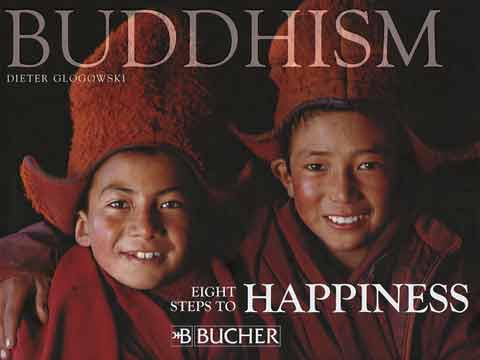
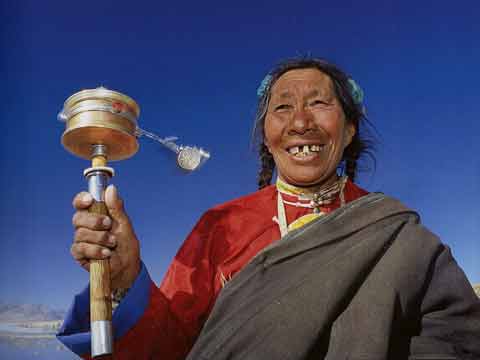
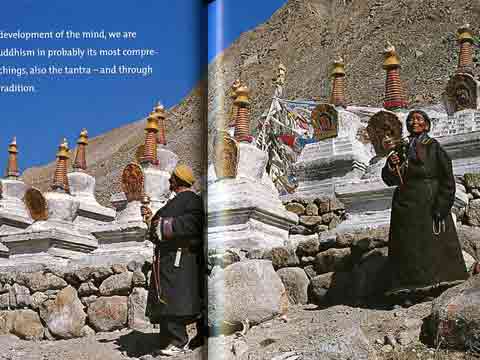

by Dieter Glogowski. Published in English 2008. Dieter Glogowski alternates his photos with Buddhist-type quotes from the 14th Dalai Lama, the Dhammapada, Mahatma Gandhi, Thich Nhah Hanh, and Mother Teresa, among others, to illustrate Buddhist techings on wisdom, consciousness, compassion, equanimity, love, impermanence, mindfulness, and meditation. The photos feature Tibet (Lhasa, Mount Kailash, Gyantse and Shigatse), Kathmandu (Pashupatinath, Boudhanath, Swayambhunath), Nepal (the Terai, Lower and Upper Mustang, Khumbu), India (Ladakh, Dharamsala, South India), Bhutan, and Sikkim. Some of the photos have already been shown in his other books.
My favourite quotes from the book are: Wisdom - 14th Dalai Lama: It is important to know that there are three kinds of wisdom: / Wisdom resulting from listening, / wisdom resulting from reflection and / wisdom resulting from meditation.
Consciousness - the Dhammapada: We are what we think / All we are arises from our thoughts / With our thoughts we create the world.
Compassion - Mother Teresa: Always try to act in a way that people are happy to have met you.
Equanimity - the Suttanipada: We exchange the breath of air with the rain forests. We drink the very water that flows into the ocean. Water and air are integral parts of our lives. And we are part of the whole world. We realize that we depend on each other, that we are related to each other. Then we will deal with all of nature carefully, we are part of it.
Love - Phil Bosmans: A flower needs sun to become a flower. / A human being needs love to become a human being.
Impermanence - 14th Dalai Lama: It is my firm conviction that the power of the gun barrel is of limited time. / But the power of truth will increase more and more with time.
Mindfulness - Thich Nhat Hanh: Real life is experienced here and now. The past has already gone; the future has not yet come. Only in the present moment can we truly live life.
Meditation - Sogyal Rinpoche: The gift of learning to meditate is the greatest gift you can give yourself in this life. For it is only through meditation that you can undertake the journey to discover your true nature, and so find the stability and confidence you will need to live, and die, well; Meditation is the road to enlightenment.
Dieter Glogowski is my favourite contemporary Tibet and Nepal photographer. His photos are excellent. The quotes are short and thought-provoking.
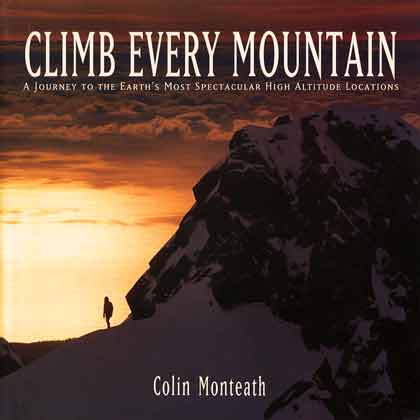
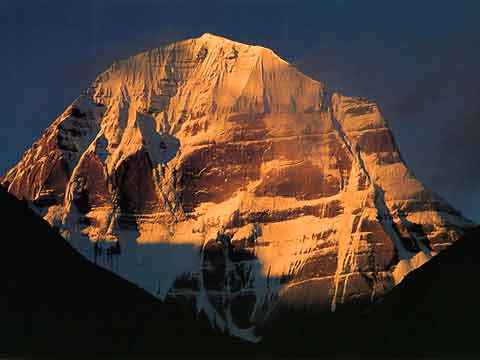
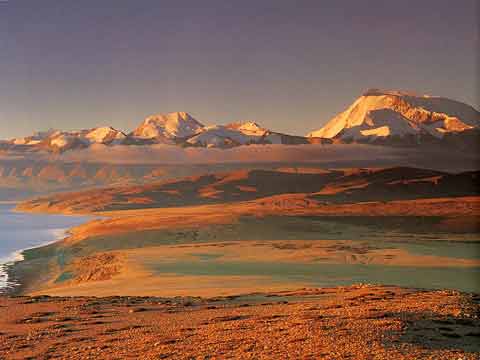

by Colin Monteath. Details 12 of Colin's treks over the years - Greenland, climbing Chongtar near K2 North Face, New Zealand Alps, Everest Kangshung East Face, Mount Kailash and Gurla Mandhata, northern Bhutan. Mongolia's Altai mountains, South Georgia on Shackleton's route, Tibet's Kangri Garpo mountain, ski traverse of Mount McKinley, Nepalese side of Kangchenjunga, and Tiera del Fuego and Patagonia.
There is an 18-page chapter on Colin's 1998 trek via Simikot to Mount Kailash in Tibet and an attempt to climb Gurla Mandhata, getting to within 150m of the summit. "Dazzled by the brightness of the scene, I squinted and stared at Kailas, seemingly afloat above the holy lake of Rakas Tal and Manasarovar, vast life-giving oceans of turquoise water adrift on a parched highland desert. I stood transfixed ..."
Colin's photos are excellent.
There are many many trekking and informational websites, with my favourites being:
I thoroughly enjoy reading other people's travelogues and looking through their photos. Here are my favourites:
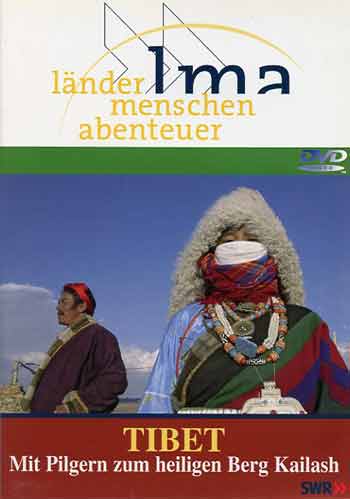
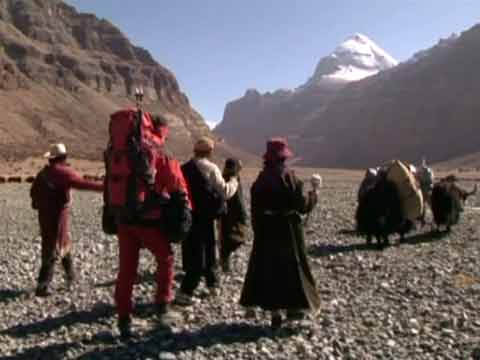
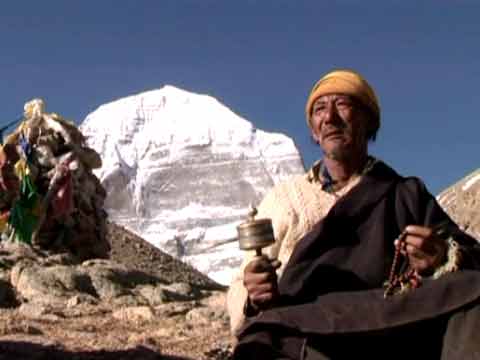

by Dieter Glogowski. After watching Dieter's progress on his trip to Kailash in 2005 at the Jack Wolfskin website, I decided to buy his German book and DVD. The 43-minute video follows Glogowski as he brings a small golden statue of Avalokiteshvara from Kathmandu back to its home at Mount Kailash. Go to Dieter Glogowski if you want current information.
Glogowksi travels with the pilgrims in the back of a truck to Kailash, and then treks around Lake Manasarovar. He meets Norbu, a Tibetan pilgrim, and after three days trekking arrives at Chiu Gompa, where they meet Norbu's parents, Tashi and Dolma. After attending the annual Saga Dawa festival and the raising of the Tarboche Pole, they trek to Dirapuk and on to the Dolma La. Having completed more than 13 koras, Glogowski and Norbu trek the inner kora, leaving the statue of Avalokiteshvara next to the south face of Kailash.
The narration is in German, but the story is self-evident, and the filming, from the pilgrims to the mountain, is excellent.
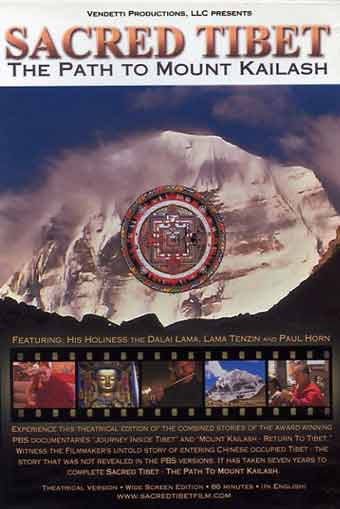

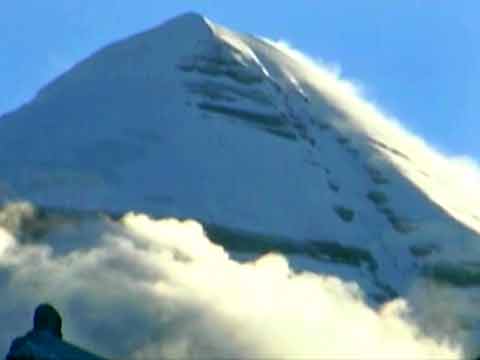

This 102-minute video combines PBS documentaries "Journey Inside Tibet" and "Mount Kailash - Return To Tibet". It includes a bonus feature with the Dalai Lama speaking about Mount Kailash and Paul Horn surreptitiously playing his flute inside the Potala Palace.
The first half of the film traces the journey of Lama Tenzin, who escaped from Tibet to Kathmandu, and flutist Paul Horn from Kathmandu to Lhasa passing beautiful Tibetan scenery on the way. Lama Tenzin had to dress in Western-style clothes to ensure he wouldn't get caught. The smile on the Lama's face as he meets his family in Shigatse for the first time in 40 years was the very image of worldly happiness. Horn wanted to fulfill a personal desire to play his flute inside Potala Palace in Lhasa. He persuades a monk to allow him to play in The Grand Assembly Hall when the workers take their lunch break.
The second half of the film follows the 2003 pilgrimage of the 71-year old Horn to release Lama Tenzin's ashes, who died in 2001, on sacred Mount Kailash in West Tibet. After witnessing Saga Dawa and the raising of the Tarboche pole, he treks around Mount Kailash, riding a yak when the going gets especially hard like the strenuous crossing of the 5630m Dolma La. I especially liked the long sequence watching the sun rise on the mist-filled summit of Kailash, with Horn's flute providing the perfect background.
The filming is slow and easy, bringing out the expansiveness and quiet of the vast Tibetan plains. "I can hear the silence. I can hear the wind. I can feel the wind. It's being away from everything, and I feel the chatter in my mind each day is getting less and less and less and less." - Paul Horn.
You can buy the music from the video in Paul Horn's CD - Tibet: Journey to the Roof of the World.
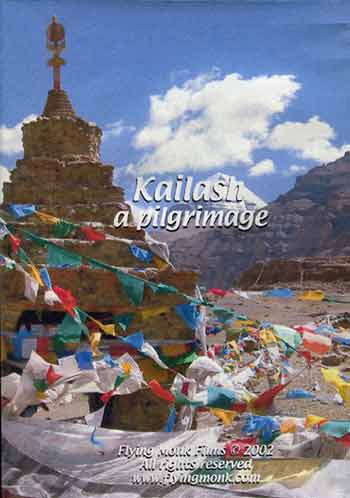
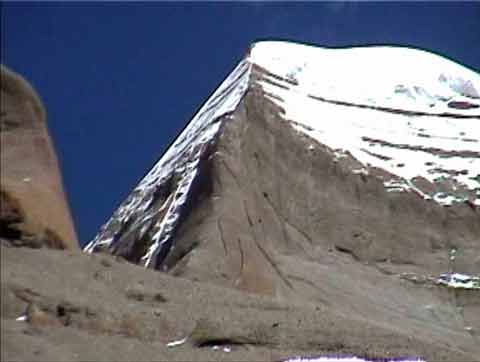
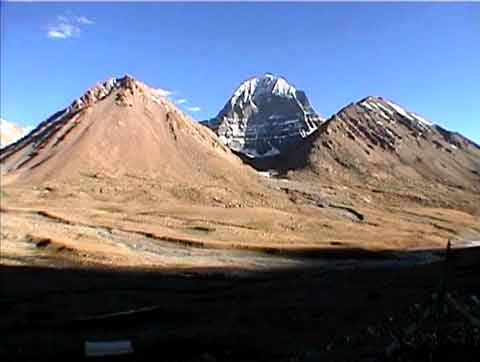

Filmed in 2002, this 88-minute video from FlyingMonk Films starts off with the drive to Kailash, passing Saga, Zhongba and Paryang. The three-day Kailash kora is shown in detail, describing each of the major highlights like Darchen, Tarboche Pole, Chuku Gompa, Dirapuk, and the 5630 Dolma La, The images of Kailash are superb, including the south, west, and north faces. After Kailash they explore Lake Manasarovar. From Kailash they back track to Tingri and take the detour to Rongbuk Monastery and Mount Everest. They trek to base camp and up to Camp 1. The introduction to the video has scenes from the major monasteries in Tibet - Sakya, Tashilhunpo in Shigatse, Gyantse's Kumbum and Pelkor Chode Monastery, and the Jokhang Temple in Lhasa.
The filming is very good, nice and slow, perfectly illustrating the vastness of the Tibetan plateau. The narration is well done, describing the sights very well. The descriptions of Buddhism and its symbols like prayer flags, prostration, statues and paintings are expertly explained.
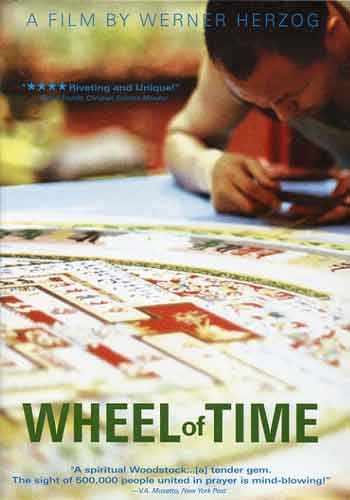
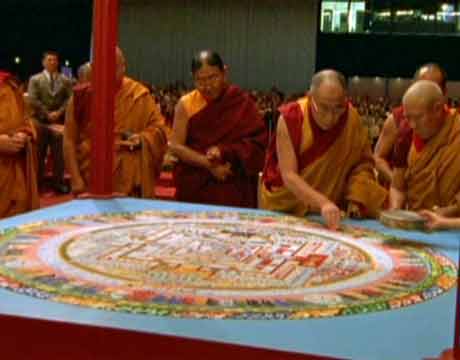
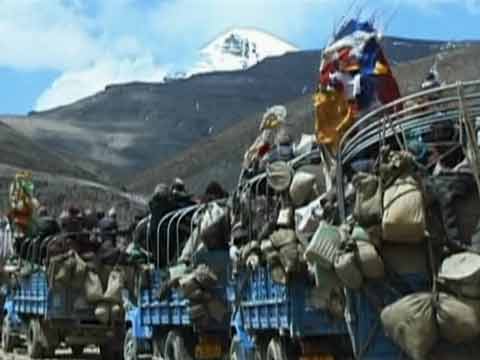

Directed, written, and narrated by Werner Herzog. Released 2003. 80 minutes. A documentary in three parts: the Kalachakra Mandala Initiation in January 2002 for 500,000 pilgrims and monks at Bodh Gaya, India where the Buddha attained enlightenment; a visit to the Saga Dawa festival at Mount Kailash in Tibet; and the Kalachakra Mandala Initiation for 8,000 people at Graz, Austria in October 2002.
The Bodh Gaya initiation was postponed to 2003 because the Dalai Lama was sick. The film shows the grounds of Bodh Gaya, the pilgrims and monks, the making of the sand mandala, and the feeding of such a large number of people.
Mount Kailash is perceived to be a mandala by Buddhists, Hindus, and Bons. This portion of the film starts with the pilgrims arriving on open-backed trucks and prostrating when they see Kailash for the first time. It follows the pilgrims to the Saga Dawa festival with the raising of the Tarboche pole. It concludes with the Kailash kora to the north face of Kailash, some of the pilgrims prostrating the whole way.
The Dalai Lama does preside over the Graz Kalachakra initiation. The film shows the monks creating the sand mandala and the Dalai Lama destroying the mandala at the end of the initiation, signifying impermanence. In addition, Mattieu Ricard interviews Takna Jigme Sangpo, an old Tibetan who had just been released by the Chinese after 32 years in prison, mostly for shouting Free Tibet.
I really liked the Kailash and Graz portions of the film - short, tight, and well filmed. I especially liked the interview of Takna Jigme Sangpo - he is so kind, warm-hearted and positive for somebody persecuted by the Chinese for so long. I think the The Bodh Gaya portion of the film was too long, and focuses too much on the background of the initiation. The close ups of the faces of the monks and pilgrims visually tell the story of their devotion.
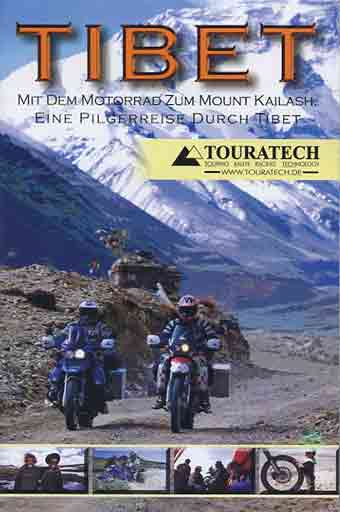
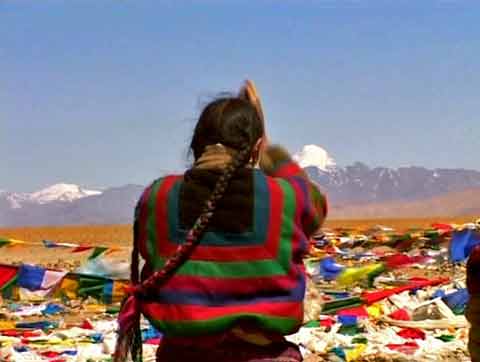
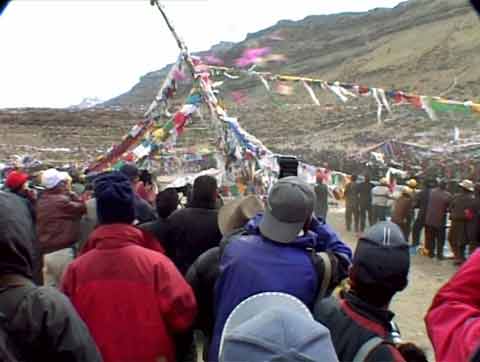

by Touratech. 52 minutes. In German. Filmed in May 2002. Starring Heike Bogdanski and Herbert Schwarz. After a brief stop to visit Swayambhunath in Kathmandu, they travel by motorbike along the Friendship Highway to the broad Tingri Plain in Tibet with views of Cho Oyu, and then over the Pang La to see Everest North Face.
They then travel by Lhatse to Saga and on the Kailash. They meet truckloads of pilgrims and many local people and nomads. The scenery in Western Tibet is broad, expansive and dusty. The pilgrims prostrate at the first sight of Kailash, and then attend the colourful Saga Dawa Festival with the raising of the Tarboche Pole. A brief visit to Chiu Gompa on the shore of Lake Manasarovar ends the film. There is a ten minute bonus with Herbert's comments along the way.
The narration is in German, but the story is self-evident, and the filming, from the pilgrims and local people to the Saga Dawa festival, and Kailash, is excellent. However, they did not do the Kailash Kora, and I think the film focuses a bit too much on the traveling, rather than the sights and people.

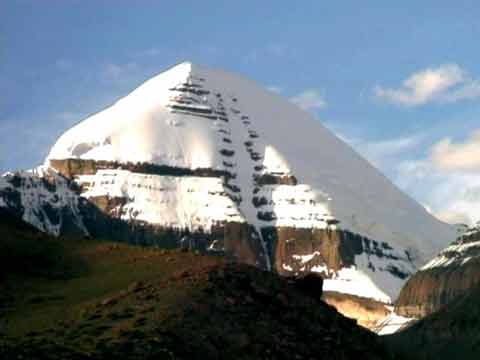
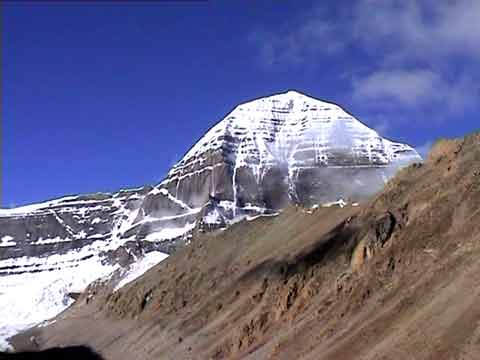

Welt Weit. 2006. 60 minutes. In German. This video starts off with 44 minutes visiting Lhasa. After some general scenes of Tibetan landscape and some black and white archival footage of the invasion of Tibet by Mao and the Chinese, the video jumps to the summer of 2005 showing the vastly Chinese portion of the city, including the gaudy amusement park across from the Potala. The video then visits the Potala Palace, the Barkhor, Jokhang Temple, Norbulingka, and Drepung Monastery.
There is 4 minutes on Shigatse, 2 minutes on Katok monastery in East Tibet, and 10 minutes on Mount Kailash. This DVD also has a bonus feature (25 minutes) of the best of Nepal excerpted from DVDs Nepal Himalaya-Trekking im Reich der Achttausender, and Nepal - Königsstädte im Kathmandu-Tal.
The filming is very good with scenes even inside the Potala, Jokhang, and Norbulingka, which are normally not allowed. Although short, the portion of the video on Mount Kailash is very good, showing the pilgrims doing the Kailash kora, monks chanting inside Zutulpuk, and a few scenes of Lake Manasarovar. This is one video where I wished I understood more German than I do, as the narration appeared to be nicely detailed.